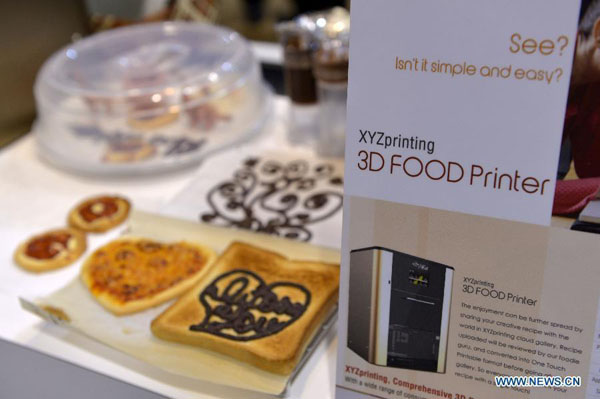3D printers keeping navy shipshape
By ZHAO LEI (China Daily) Updated: 2015-01-09 08:36
 |
|
The 3D printed food is seen at the 2015 International Consumer Electronics Show (CES) in Las Vegas, Nevada, the United States, on Jan 6, 2015. [Photo/Xinhua] |
The PLA Academy of Armored Forces Engineering, where Xu works, has developed a specialized 3D printer that can make most metal parts of an armored vehicle or tank.
It can "print" a part at a speed of up to 100 grams per second, but precision components such as gun barrels are still beyond its capability.
Zhang Junshe, a senior researcher from the PLA Naval Military Studies Research Institute, told China Daily, "As far as I know, the 3D printer is still in the trial stage for the navy.
"It has bright prospects, but whether it can be quickly promoted to all units will depend on its cost."
Navy ships carry many small replacement parts with them on voyages to repair minor damage or fix malfunctions, but they have to return to the home port or shipyard if serious problems occur, Zhang said.
In December, China Aerospace Science and Technology Corp announced that its scientists had produced a special 3D printer for use by astronauts on space missions.
The machine is capable of printing optical lens brackets used in spacecraft-borne equipment, complicated components used in testing a nuclear power apparatus, impellers used in aircraft research and special-shaped gears used in automobile engines, said Wang Lianfeng, a senior engineer at the company's Shanghai Academy of Spaceflight Technology.
- Govt encourages people to work 4.5 days a week
- Action to be taken as HIV cases among students rise
- Debate grows over reproductive rights
- Country's first bishop ordained in 3 years
- China builds Tibetan Buddhism academy in Chengdu
- Authorities require reporting of HIV infections at schools
- Typhoon Soudelor kills 14 in East China
- Police crack down on overseas gambling site
- Debate over death penalty for child traffickers goes on
- Beijing to tighten mail security for war anniversary







